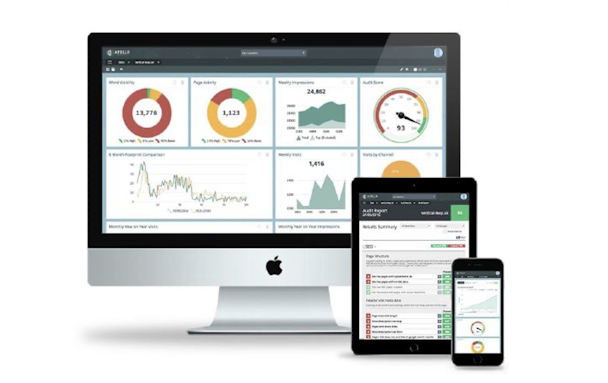How to use robotic process automation to improve marketing efficiency
Robotic process automation (RPA) empowers marketing teams to achieve more with fewer resources by doing the heavy lifting with data and repetitive tasks. Research carried out by Uipath finds that 68% of global workers believe automation makes them more productive, while a separate study by Forrester reveals that 57% of workers say RPA reduces manual errors.

Automation technology is constantly improving, but it’s already making a huge impact on the way marketing teams work with data
Automation technology is constantly improving, but it’s already making a huge impact on the way marketing teams work with data. In this article, we look at several ways we use robotic process automation to improve marketing efficiency and achieve bigger things for our clients.
What is robotic process automation?
According to Uipath, “robotic process automation (RPA) is a software technology that makes it easy to build, deploy and manage software robots that emulate human actions interacting with digital systems and software.”
In other words, RPA performs digital tasks normally carried out by humans, pulling in data from one or more applications and using this input data to complete pre-programmed actions.
For example, we have our own intelligent automation platform, called Apollo Insights, which pulls in data from hundreds of sources, collates this data into reports and uses machine learning to spot trends and make marketing recommendations – all without human input.
So, instead of having an army of data scientists crawling through reports every day to find new opportunities, Apollo compiles all of this data for us and even spots new keywords or content opportunities for our clients.
Robotic process automation carries out time-consuming, repetitive and large-scale tasks so marketers can spend more of their time on creative work that can’t be automated.
Examples of RPA in marketing
Here are some other examples of RPA in action:
1. Automatic bid adjustments
Another crucial task we automate with RPA is bid adjustments for PPC campaigns. In Google Ads, you can schedule ads to show at specific times and optimize bids to increase during the moments when purchase intent is highest among your target audience.
At a basic level, you might increase bids on Friday evenings if this is when conversions are typically highest, for example.
We can go so much further than this using RPA and intelligent automation, though. For example, we can pull in historical data to look at external factors that impact sales, such as the weather, consumer trends, current events, economic fluctuations, changes in purchase habits and anything else identified as having an impact upon sales.
So, instead of using primitive bid adjustments to increase spend on Friday evenings, RPA can automatically optimize your bids as events unfold, so that you’re always getting the best return on your ad spend.
2. Automating technical SEO reports
Technical SEO can put a real drag on resources if your search marketing team is manually running audits and reports. Scale quickly becomes a problem too, because a human team is only capable of running so many audits every year. Even if you’re performing link audits every month, for example, any broken links or low-quality inbound links can cause up to a month’s worth of damage before you detect them – let alone fix them.
By automating these audits and reports, these can run constantly in the background so issues are detected right away – before they cause any damage –and your technical SEO team only needs to jump in when an issue needs fixing.
3. Automatic lead nurturing
In the digital age, the buyer decision process is becoming longer every year. This forces brands to invest more time and resources into nurturing leads from prospects into paying customers. Sooner or later, growth is bottlenecked by the volume of leads your sales and marketing teams can physically handle.
The only way to sustain growth is to automate as much of the lead nurturing process as possible. This allows sales and marketing to focus their efforts on the pivotal moments of influence – the interactions that really turn prospects into buyers.
Here are three key lead nurturing tasks that RPA is great at handling:
-
Lead qualification: You set the criteria for leads worth pursuing (for example budget, timeframe, first purchase value or predicted customer lifetime value) and only invest resources in leads that meet your needs.
-
Lead scoring: Algorithmically scoring the quality of leads to prioritize high-value prospects or those most likely to commit.
-
Churn prevention: Automatic campaigns that keep your customers engaged and buying from you regularly, and prevent them from doing business with your rivals.
By automating these processes, every marketing and sales action is focused on the prospects that matter most to your business. You can also target campaigns with greater accuracy and the quality of your data improves because messages are always reaching the most relevant audience.
Instead of wasting manual resources on segmenting data and qualifying leads, marketing teams can concentrate their efforts on creating and optimizing campaigns that inspire real action.
Chris Pitt is managing director at Vertical Leap.
Content by The Drum Network member:

Vertical Leap
We are an evidence-led search marketing agency that helps brands get found online, drive qualified traffic to their websites and increase conversions/sales.
To...

